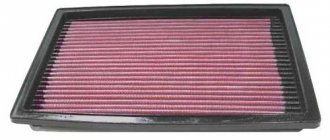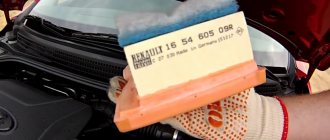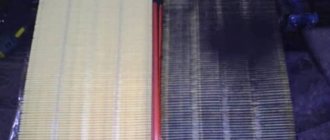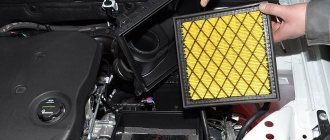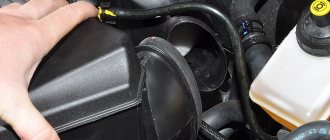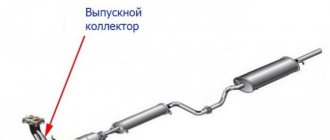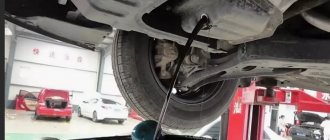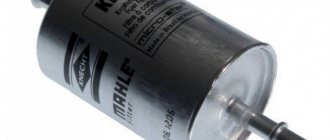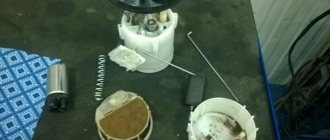Question No. 1: why is the car air filter covered in oil and the reasons for this phenomenon?
This question arises among some car enthusiasts during the next air filter replacement; moreover, this fact causes confusion among many. According to their opinion, there can be no connection between the lubrication and air filtration systems of internal combustion engines. However, even minimal knowledge of the principles of operation of the power unit makes it possible to refute this concept.
In fact, the answer to the riddle of why the air filter is in oil is simple - in addition to the main air flow, crankcase gases also pass through the filter element. Moreover, their concentration is directly proportional to engine wear. Serious problems with the cylinder-piston group lead to the penetration of lubricating fluid into the crankcase and the appearance of excess pressure, which destroys the seals. All these factors contribute to unwanted penetration of lubricant into the air filter.
Based on the experience of practicing craftsmen, we can outline the most common reasons why oil ends up in the filter element:
- High levels of wear and coking of the piston rings, which does not allow excess lubricant to be effectively removed from the cylinder walls, and the substance penetrates into the crankcase.
- The oil deflector drain is clogged and the remaining lubricant cannot return to the crankcase, so the air filter is filled with oil supplied with crankcase gases.
- Clogged crankcase gas throttle outlet hose.
- The filter element loses its performance characteristics; in other words, the air filter becomes contaminated with dust. Due to the insufficient volume of incoming air, the engine begins to compensate for this parameter by suction from the crankcase.
Why do you need a cold intake and how to implement it
Replacing the fuel line of a VAZ 2110 with your own hands
We noticed that in hot weather, in a traffic jam or at traffic lights, the car accelerates worse, and after a while the throttle response returns. This is due to the fact that if the engine temperature is higher than the opening temperature of the thermostat, but lower than the temperature when the fan is turned on, then the system to prevent detonation delays the ignition to the late side. After you start driving, the air flow cools the radiator to the opening temperature of the thermostat, and the dynamics return. The system, realizing that the temperature has dropped, returns the OZ to its previous value.
There are several ways to make a cold air intake for the engine:
- Using aluminum corrugation
- Using plastic pipes
Cold intake made of aluminum corrugation
As a result, the new highway will have a snail shape. This design has been tested for years, and we can say that it is not inferior in reliability to the standard one.
Let's find out the reasons why engine oil gets into the car's air filter?
First of all, you need to understand that the detection of even minimal traces of lubricating fluid in the air purification device indicates a malfunction in the operation of the power unit. This fact cannot be ignored, because in the end such irresponsibility ends in expensive repairs. Experienced car enthusiasts recommend immediately performing several simple operations to determine the reasons for lubricant getting into the air filter:
- Check the compression level in each cylinder. Indicators that range from 9 to 12 atmospheres are considered normal. Deviations in numbers between cylinders should be no more than 1 atmosphere. If the compression does not meet the minimum parameters, then this is a direct indication of problems with the engine.
- Assess the color of the smoke from the exhaust pipe. A black or blue tint indicates wear of the elements of the cylinder-piston group.
If the compression readings are normal and the color of the smoke does not raise suspicions, then you can relax a little - the troubles are not so serious. The most likely reasons why oil gets into the air filter is that it is clogged or the hoses with channels through which crankcase gases are discharged are obstructed.
Solving the problem is not particularly difficult - just replace the filter element, clean or replace the hoses. For complex cases, a temporary resolution of the issue is also possible, which still does not cancel serious repairs.
If your car's air filter is filled with oil: a quick way out
Such a way out of the situation, of course, will not completely eliminate the entry of lubricating fluid into the air filter, but it does provide the opportunity to operate the car for some time. To do this you need to perform the following operations:
- disconnect the hose that supplies crankcase gases from the filter fitting;
- close the fitting;
- connect a longer hose to the crankcase ventilation so that its lower end is located below the engine level.
Briefly about the prevention of ICE
In conclusion, we will consider some aspects of preventive measures designed to prevent the moment when the car’s air filter fills with oil due to defects in the cylinder-piston group. Their essence lies in the following points:
- Change the lubricant more often; if the manufacturer recommends, for example, changing it after 15,000 km, then you do not need to maintain this particular interval - it is better to change it after 10,000 km. The fact is that the timing depends on many parameters, including seasonality, operating conditions, and the quality of fuels and lubricants.
- Purchase only certified lubricants.
- Be sure to combine an oil change with the installation of new air and oil filters.
- Use only high-quality fuel from proven brands.
These simple rules will improve the performance of the motor and also increase its service life. It would not be superfluous to install a universal oil catcher on the crankcase gas supply tube. Its price is low, but the effect of its use will not be long in coming - the filter element will be reliably protected from lubricant penetration.
The air filter is an important consumable component that protects key engine components from dirt, dust, stones, insects and other debris that can harm the stable operation of the engine. The air filter should be changed every 10-15 thousand kilometers, or in accordance with the manufacturer's recommendations.
When replacing, the driver may encounter the problem that traces of engine oil appear on the filter element. In some situations, the driver pays attention to this due to symptoms of improper operation of the air filter, which has not yet completed its required mileage. It is prohibited to operate a filter that contains traces of engine oil for reasons of safety of the car engine. At the same time, installing a new filter element will not get rid of the problem, since after a few kilometers of run oil traces will appear on it. Before changing an air filter that has traces of oil on it, you should find the problem and fix it.
Heater heat exchanger hoses
The other hoses in the VAZ 2110 cooling system are those connected to the heat exchanger of the heater.
Hose diagram
, the O-rings must be replaced . Therefore, we advise you to purchase them in advance. The dismantling procedure itself is as follows.
- Two heater hoses are connected to the heat exchanger using a single connector. Some modifications of the VAZ 2110 may require dismantling the camshaft cover.
- Remove the metal clip that is located on top of the connector.
- Push the plastic tab towards the left side of the connector to release it.
- Remove the heat exchanger connector, remove the old O-rings. It is strongly not recommended to return the same ones to their place.
- An alternative to such connectors can be hoses with a spring clamp made of metal.
Why does oil get into the air filter?
Engine oil in the air filter is a serious problem, which indicates the presence of damage to key engine elements, or their malfunction for one reason or another. If oil gets into the air filter, it most often happens for the following reasons:
- The oil deflector drain is clogged, which is why residual oil cannot return to the crankcase, and it will exit through the air filter along with crankcase gases;
- Piston rings are stuck, damaged or worn. This will prevent the rings from properly collecting excess oil that will begin to leak into the crankcase. Accordingly, dirty oil will begin to be squeezed out through the oil deflector and valves intended for ventilation;
If the driver has not changed the air filter for a long time, you should first make sure that the problem is not related to it. To do this, you will need to install a new filter element, drive several kilometers, and then examine it for oil stains. If oil continues to get into the air filter, more thorough engine diagnostics will be required to determine the cause.
Preparation
Silicone
It is necessary to remove the pipes only when the car engine has completely cooled down. Therefore, if you have just stopped by your garage for procedures, do not rush. It is better to leave the car overnight and return to work tomorrow morning.
- Make sure that the pipes are actually damaged and need to be replaced.
- Be sure to drain the coolant from the system. If you recently changed it, there is no need to dispose of the liquid. Just use a clean container to drain so you can refill it later.
- The order in which you perform the work depends on what hoses are used on your vehicle.
Can you drive your car if oil gets into the air filter?
If the driver aims to delay engine overhaul as much as possible, then it is necessary to quickly respond to such serious problems as engine oil getting into the air filter. In such a situation, it is necessary to identify the cause of the problem as quickly as possible and eliminate it, since the malfunction can be very serious.
If there is no way to fix the problem at a particular time, and the machine needs to be operated, you can temporarily prevent oil from getting into the air filter. To do this, you will need to disconnect the hose from the filter fitting, which removes gases from it. Next, the fitting is sealed, and the crankcase ventilation is removed using a longer hose below the engine.
Important: This solution to the problem is temporary, and it can be used to drive the car to a service center for full diagnostics and repairs.
What to do to prevent oil from getting into the air filter
The problem with oil getting into the air filter is typical for older engines that have traveled more than 150-200 thousand kilometers. To delay as much as possible the moment when engine oil begins to enter the filter element, it is recommended to properly monitor the engine:
Buy high-quality oil recommended by the car manufacturer. Remember that motor oil from major brands is often counterfeited, so you should purchase the fluid from reputable stores;
High-quality consumables are the key to the “health” of the engine. It is better not to skimp on oil, gasoline and filters so that the need for major engine repairs does not appear too early.
A part such as a car air filter performs a very important function. It serves to clean the air entering the engine, necessary for the formation of the fuel mixture, from various pollutants (litter, sand and other abrasive particles). If air that has not undergone such purification enters the engine, the cylinder walls may be subject to rapid wear, and the engine itself will ultimately fail.
It is to transfer such purified air from the filter to the engine that the VAZ 2114 air filter pipe, which has the form of a corrugated channel of complex shape, is used.
The most common type of damage to this part is mechanical, most often ruptures of the outer shell. Their reasons are simple and understandable, but sometimes troubles arise that make the car enthusiast much more worried - such as oil getting into the filter bellows.
Eliminating the causes of oil condensation in the pipe
The very first thing to do when this problem occurs is to check the oil level. If it is higher than normal, then the excess should be drained immediately. After this, its level should be between the minimum and maximum marks on the oil dipstick.
If after adjusting the oil level (or if it was not needed at all) the problem remains, then the crankcase ventilation ducts should be cleaned. This is very simple to do - just start the car and let it idle for half an hour or a little more. This is usually enough to restore normal operation of the ventilation ducts.
For preventive purposes, it is recommended that every day you intend to use the machine, let it first idle for a while. This will help completely get rid of the problem of clogging of the crankcase ventilation ducts.
If it was not possible to clean the channels at idle speed, and they are really seriously clogged with carbon deposits, you will have to clean them manually. It is best to do this in a car service center or with special equipment, since for complete cleaning you will have to disassemble the engine itself.
Another common reason for which there is oil in the air filter pipe of the VAZ 2114 and which you can fix yourself is a damaged air filter. It can be either worn out (with signs of destruction) or heavily soiled.
In any case, its damage leads to difficulty in the passage of air flow, and this, in turn, leads to an increase in pressure and oil emissions from the crankcase. In order to eliminate this reason, you just need to replace the air filter with a new one.
Sometimes, although quite rarely, the reason for the appearance of oil in the corrugation is the oil itself (for example, low quality). Therefore, if the car’s engine is in good working order, and all other attempts to eliminate oil getting into the pipe have not helped, then it is worth trying to completely replace the engine oil with a product of a different brand.
If all of the above methods did not have the desired effect, then you should think about the most unpleasant option - wear and tear on the elements of the engine itself. This (besides oil ingress) may be indicated by the following signs:
- Difficulty starting.
- A sharp drop in power.
- Black exhaust smoke.
- Unstable operation at idle.
- Compression loss in cylinders.
If the car exhibits at least one of these signs, you should stop using it and contact a car service center for a complete engine diagnosis.
Air filter corrugation VAZ 2110 8 valves injector
- To the beginning of the forum
- Forum Rules
- Old design
- FAQ
- Search
- Users
Explain what it gives with this arrangement, except for the extra path,
that air passes through the mentioned pipe BEFORE the filter.
Or am I missing something about this funny, trunk-shaped device?
It still sucks in cooler air there at the mounting point, otherwise the entire flow of hot air from the radiator will be sucked in, which is unacceptable.
Explain what it gives with this arrangement, except for the extra path that air passes through the mentioned pipe BEFORE the filter. Or am I missing something about this funny, trunk-shaped device?
And the hose mentioned logically also heats up (by itself) from the same radiator..
This is not a heat exchanger at all; the air speed there is immeasurable.
.I put on the corrugation and brought it to the bumper, and in the bumper (at the towing eye) I cut a large slot and brought it there
Damn, I did it right, the engineers should hang themselves now, how come they didn’t think of that before.
1. The corrugation has aluminum foil that reflects heat. 2. The air intake is located where, even with a wave, there will be an air bubble on the hood, which will collapse there last. 3. Less dirt flies onto the filter under various dynamic AM conditions.
I’ll keep quiet about what you did.
Vlad B Yes, it’s very nominal there.. I looked, there is no hot air there at the neck of the filter.. It stands quite high (this neck). And the hose mentioned logically also heats up (by itself) from the same radiator.. In general, I tore it off corrugation
I'm thinking about the right thing to do
Source
Do I need to replace a worn or damaged pipe?
Some motorists believe that you can drive with a cracked pipe, but this position is fundamentally wrong. Firstly, a damaged pipe will not be able to supply clean air to the engine. After all, through the gap, air from under the hood will enter it, which has not been filtered, and therefore carries abrasive particles (which, as mentioned, can quickly damage the engine).
Secondly, driving with a damaged corrugation also leads to faster wear of the air filter; it will have to be changed much more often. That is why a damaged or worn pipe should be immediately replaced with a new one.
Air filter corrugation VAZ 2110 8 valves injector
Drasta! In general, I’ll tell you briefly: I opened the hood on the top ten, noticed that there was no trunk on the box with the air filter, well, that trunk that goes to the hood and through which it sucks air. So we started thinking: does it actually have any meaning at all, or is it better without it, or is it even better to take it somewhere else? Share your thoughts!
Well, for some reason, the factory firmware also changes everything.
To transfer the fungus in order to place it higher, you need to greatly lengthen the corrugation, and it is better not to place it lower. But whether or not to raise the issue at a price of 100 rubles is a matter of business.
take in cold air, important in hot weather (the air intake is located at the hood crack
The corrugation is also needed to take in cold air, and this is its main purpose.
the hottest air under the hood - which collects in its upper part
when driving, hot air from the radiator and engine goes down under the car
According to the laws of physics, hot air can only rise upward
But when driving at speed, hot air from under the hood is pulled under the bottom.
According to the laws of physics, hot air can only rise upward
Remember how the “thermal” curtain at the entrance to hypermarkets works. Warm air blows from top to bottom.
I agree with the law of physics, but when driving, the oncoming flow, passing through the radiator and engine compartment, exits under the bottom, since the “top” is closed by the hood lid. Remember how the “thermal” curtain at the entrance to hypermarkets works. Warm air blows from top to bottom.
when moving, the air blows on the radiator, behind the radiator the air turns out to be warm, the box with the filter is located behind the radiator, it turns out that when moving it sucks warm air. where to find a place to suck cold.
Source
